
|
||
|
Portland art blog + news + exhibition reviews + galleries + contemporary northwest art
|
||
|
Friday 04.28.17 Late April Links I've been traveling and unpacking those sojourns and recently catching up on shows. There will be many articles on the way to round out the month. First though let's catch up.
Sad news, Vito Acconci has died. PORT interviewed this trouble making giant years ago and his last answer is advice all artists should heed. Look who showed up in the New York Times, Portland's old Appendix gang is going to be moving American Medium to Chelsea. Congrats, we singled them out a very long time ago as ones to watch in this article from 2009 (they had a 5 year run in Portland as an incubator). As for terms like "Post Internet", like other terrible terms see; Minimalism, Postmodernism, Modernism, Cubism, Fauvism and Expressionism etc... its a very weak description of what is going on. More accurately it is the way geek cultures have flourished since the computer age made sharing sometimes obscure interests easier but it predates the internet and is more wholly related to the collateral effects of the computer/information age. Lots of luck as a Chelsea gallery is a very difficult thing to pull off these days if you aren't selling blue chip work. That said its what the art world needs to do. Then there is the whole mess with the Metropolitan Museum's ouster of its Director. Everyone, everywhere during my travels wanted to talk about this and Vanity Fair did a decent job of unpacking it. Really what happened was the way the Director bled out institutional experience in favor of updating agendas... and there was inter office blowback. It has nothing to do with deficits which the Met routinely runs (its a typical non profit shell game). The thing is the Met was a supreme repository of institutional knowledge (much of it arcane)... yet was moving too fast into new digital interfaces and educational mandates. With encyclopedic museums there is a danger there... to undervalue what it already does well and many such institutions have had similar problems. Basically it is disrespect for one's core competencies and I see it as a moment where the war on expertise (in the guise of edutainment) had an interesting little big horn moment. The problem is further exacerbated as many digitally savvy Gen X and Millenials just don't feel like museums are speaking to them anymore as a front for the 1%. That is a big problem, but I dont think losing core competencies is the right way to go. Charging tourists isnt the right way either... go open source. Simply put, museum's need to be a very physical manifestation of the rich making riches available to all. Last but not least the Portland Art Museum's Rothko Pavilion plan is causing some friction and Bike Portland covers it. I'm a big proponent of the Rothko Pavilion... it was my idea before PAM ever thought it even possible. Still, I believe this is a good thing. I believe that PAM was making a very understated architectural footprint to avoid stirring these sentiments up but what they needed was a bit more architectural temerity (this isnt a 1% grab of public space since the pavilion would be open to foot traffic). OK tough questions... can Vinci Hamp do a redesign that goes beyond just the basic "museum" dictates and creates something that becomes an amenity for the Park Blocks and casual passers by? Perhaps a more adventurous architect is required? Privately, I have always indicated to PAM's director that this needs to bring the museum and park blocks together as a mixing zone rather than present PAM as a bunker. I just think this site is more complicated than the current design contends with. Yes, addressing these issues will cost more $$$ but I believe the added complexity will help both PAM and the South Park blocks area become something more than what they already are... islands. What is more I'm not certain this needs to be a cyclist's super highway through the museum... that isn't a realistic or sober goal. The current space has some foot traffic and almost no bike traffic... a redesign could be more inviting... perhaps to a rooftop sculpture garden open for free 9AM-PM as a kind of Highline? Perhaps sacrifice the current tunnel? My best advice is PAM needs to be more like a park and less like a museum. That is something very difficult for most museums and boards to understand but in the current political climate being seen as a wealthy fortress isn't what they need. I could also bring some Rothko lore into this take as well (Rothko's worldview was like a lot of Portlanders of today are now). Basically. I believe there is a solution and it will make both the passer by and museum experiences better. Right now as it is the street and museum experiences are bit of a mixed bag and I hope all sides see this as an opportunity. Good can come from the Museum and the public having a strong dialog with realistic goals for once. Posted by Jeff Jahn on April 28, 2017 at 10:48 | Comments (0) PermalinkWednesday 04.12.17 Paul Clay at Archer 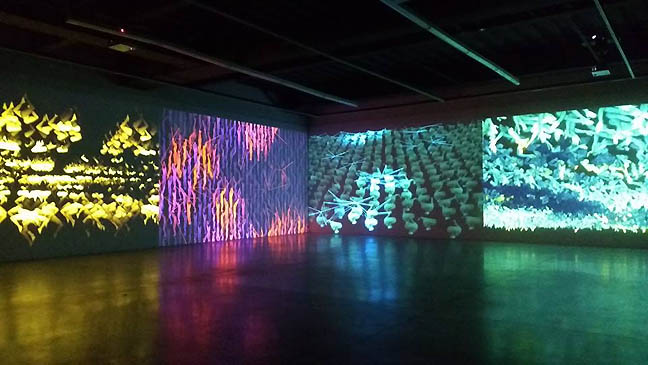 Paul Clay's Push/Pull at the Archer Gallery Archer curator Senseney Stokes is doing great things up in Vancouver Washington. Her Mary Henry micro-spective was perhaps the best solo exhibition of 2016 and now she's tapped Paul Clay for Push/Pull. He is one of the most interesting new media artists in Portland. PORT reviewed Clay's daring Portland Building show in 2014 and I've been waiting for Portland's institutions (frankly slow to support local new media despite being awash in riches) to feature him and others. Interested in the evolution of humanity and technology as well as conscience transference (more common than you'd think), Clay's Push Pull at the Archer has my full attention. He's been one to watch for years. Here's your chance. For the performance April 13 at 7:00 remember to bring a wifi-enabled smart device + earbuds or headphones. Push/Pull | April 11- May 6 Opening Reception and Performance: 6-8PM, April 13 (7:00 performance) Artist Talk: April 19 Archer Gallery Clark College 1933 Ft. Vancouver Way, Vancouver Washington Posted by Jeff Jahn on April 12, 2017 at 12:56 | Comments (0) PermalinkSunday 04.09.17 The Rodin experience at PAM 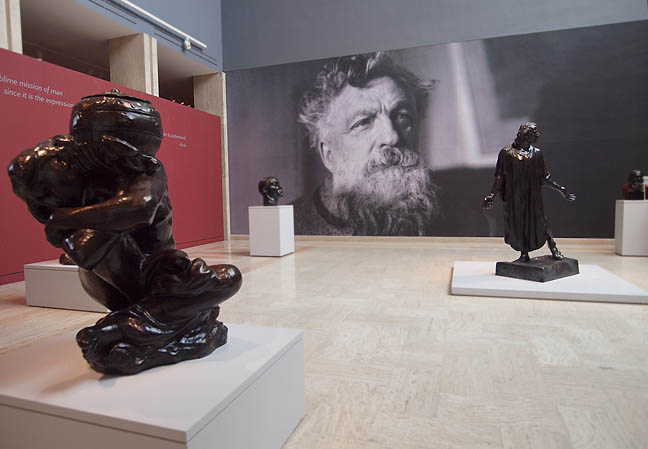 One of The Burghers of Calais, Jean de Fiennes, Clothed (center right) by Laurel Reed Pavic An enormous headshot of Auguste Rodin greets visitors to the Portland Art Museum's Rodin: The Human Experience. His face is wall-sized, bearded, with crinkly, twinkly eyes; it is everything we want to see in our artistic geniuses. The show is part of a celebration of the sculptor's work 100 years after his death in 1917. The sculptures are all from the Iris and Gerald B. Cantor Collections and part of Portland Art Museum's drive to "bring the world to Oregon" in the words of Director and now Chief Curator Brian Ferriso. The works in the exhibition are a fascinating smattering from Rodin's extensive oeuvre. The exhibition begins in the atrium with four studies or reprisals for Rodin's "breakout" commission for The Burghers of Calais (1884-1895) and two Caryatids. A cast of Jean de Fiennes, Clothed anchors the atrium grouping and provides an opportunity for a wall tag to introduce Rodin's famous public monument. The Monumental Head of Jean d'Aire to the left is also inspired by The Burghers though the head wasn't modeled until... (more) Posted by Guest on April 09, 2017 at 11:02 | Comments (1) PermalinkThursday 04.06.17 First Thursday Picks April 2017 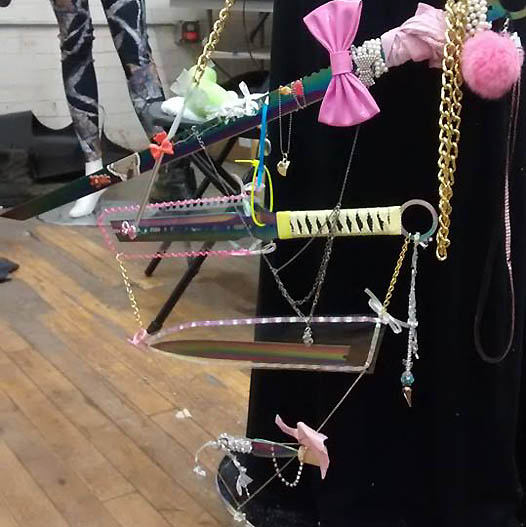 Tabitha Nickolai, Vorpal Cuck-Knives (2017) Costumes, Reverence and Forms features eight artists from two river cities (Portland and Philadelphia) together in both cities. There has been a year's worth of curatorial exchanges involving two institutions and six curators fostering new connections. The exhibition itself is more of a sampler than a survey. Costumes, Reverence, and Forms features artists; Avantika Bawa, Tabitha Nikolai, Jess Perlitz, and Ralph Pugay (all from Portland) as well as Marianne Dages, Beth Heinly, Anna Neighbor and Kristen Neville Taylor (from Philadelphia). For quite some time costume and guise have been an important way to subvert cultural norms and to impose new ones so this exhibition should be of great interest to anyone who has been paying attention Costumes, Reverence and Forms | April 6 - June 3, 2017 First Thursday: April 6, 6:00-8:00PM PNCA 511 NW Broadway 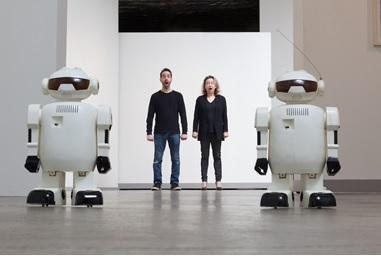
Brother sister team Merridawn and Georgie Duckler present Roboyat: Omar Khayyam's "Rubaiyat" Reimagined. Promising cacophony and the "anti-topical" this looks like a must. The artists state, "We are interested in ideas of translation, the ephemeral and daily image, what lasts and doesn't, the lineages that keep poetry and visual art alive, in science and in language as a visual medium." Roboyat: Omar Khayyam's "Rubaiyat" Reimagined | April 4- 29 Opening reception: April 6, 6-9PM Lecture: April 9, 7PM Blackfish Gallery 420 NW 9th ... (more) Posted by Jeff Jahn on April 06, 2017 at 9:56 | Comments (0) PermalinkSaturday 04.01.17 Japanese Garden's Cultural Crosssing sets the bar 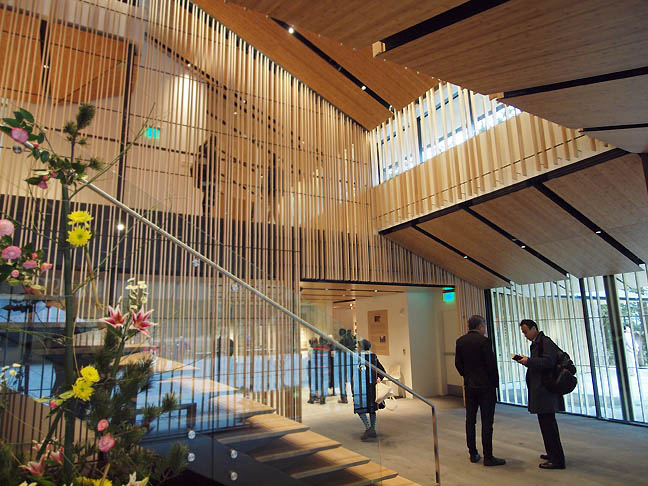 Kengo Kuma's Japanese Garden expansion transcends architecture (all photos Jeff Jahn) Architecture is the applied art of buildings that create and reshuffle the dictates of site and civilization. True architecture elevates the discussion/experience, going beyond mere shelter. When done right it becomes a meditation upon both human activity and the persistence of the site. True, most public architecture is just a thinly veiled ploy for attention, a way to organize cultural energy and perhaps focus funds upon itself but it need not be narcissistic. That said the Portland Japanese Garden's "Cultural Crossing" expansion certainly isn't vain or even stunt-like so much as an innovation driven by necessity. With over 400,000 visitors last year alone (despite being closed part of that time) the tiny and fragile garden was on the precipice of losing what made it special, being a contemplative atmosphere devoted to the Japanese way of executing exquisite excellent experiences. When done right public architecture ennobles and inspires the community it serves and as an excellent first US project by one of the world's greatest architects it certainly should perform that function. The Portland Japanese Garden's solution was to hire architect Kengo Kuma who detailed how he would create a satoyama or mountain village with PORT in an interview years ago. It was a stunning inversion, create a tiny village that would expand the cosmopolitan exploration of two cultures already engaged in a vigorous conversation. 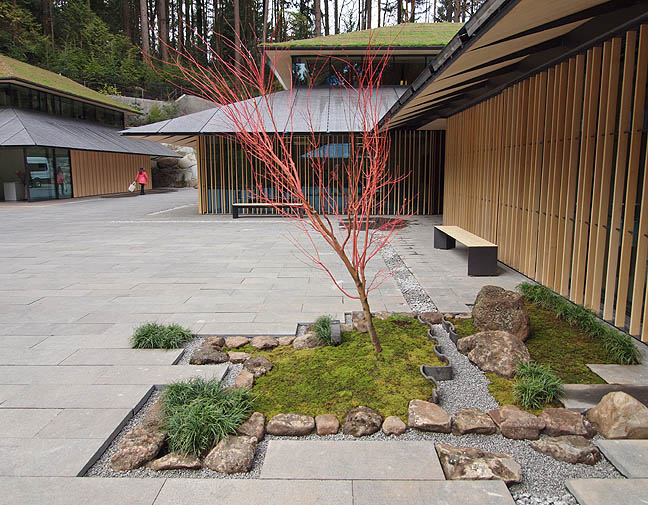 the new village courtyard Portland and the Japanese have had a mutual infatuation with each other that goes back over a century... all the way back to the 1905 World's Fair in Portland. Today, Japanese tourists flood Portland's streets... and replicate our food scene at home. Likewise, Portland's artists and cognoscenti travel to and study in Japan frequently and you can see the influence in their work. The cultural exchange in art, food, music and geek-craft is intense. Notably, Portland also boasts of having the finest Japanese Garden outside its native lands so it makes sense that this amplified cultural exchange would find its way to that site. Yet, what they have done is so much more, its the story of a small institution using a 33 million dollar project to grow into a new role... a kind of embassy of understanding and exchange. The fact that it does so by creating a cutting edge version of a medieval village, one which re-imagines feudal castle walls (typically barriers) into an invitation gives us an idea of just how innovative this project is. The buildings with their new shoji screen system echos the vertical army of Douglas Fir trees on site is poetry in the guise of place making. I've never experienced buildings so at home within a massive stand of trees. Appropriately the construction projects are not 100% complete (mostly roofs, which are living gardens themselves). It could have gone wrong so easily, but instead... (more) Posted by Jeff Jahn on April 01, 2017 at 6:01 | Comments (0) Permalink |
| s p o n s o r s |
 |
 |
 |
 |
 |
 |
 |
 |
 |
 |
 |
 |
 |
 |

|
Site Design: Jennifer Armbrust | • | Site Development: Philippe Blanc & Katherine Bovee | |

